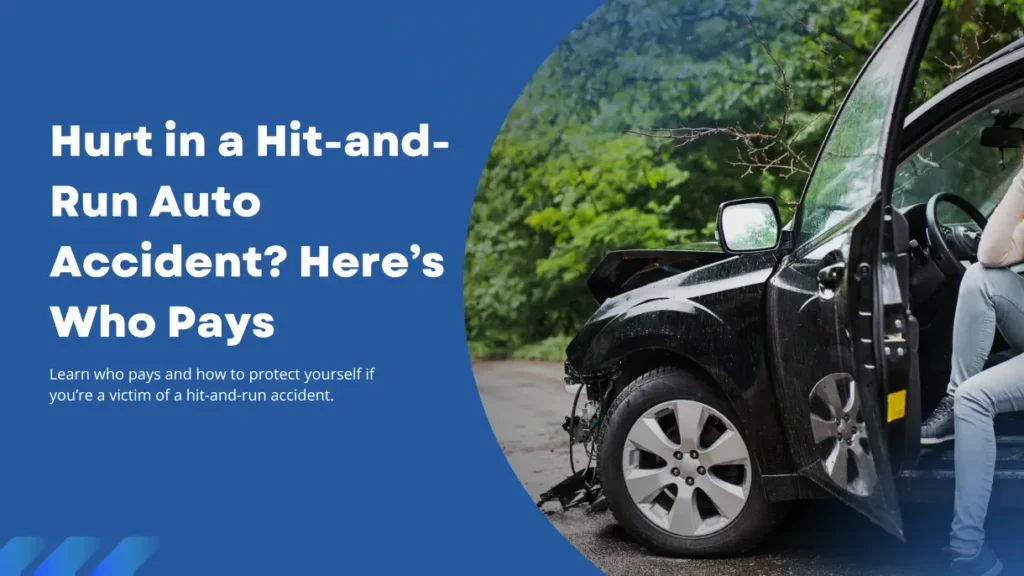When you’re injured in a car wreck, police often assign blame to either one or both drivers. Even when it’s not clear-cut, auto insurance usually pays about half the cost. (Sure, it might be your policy — but at least you’re not completely out-of-pocket on all those bills!) But what happens if you’re hurt in a hit-and-run? More to the point, who’s going to pay for the days you missed work in addition to your medical bills? Personal injury protection (PIP) can help cover medical expenses and lost wages in such cases. We’ll explain how to get the justice and damages you deserve below.
Ready to see if you may qualify? Click here to get a FREE, no-obligation consultation before starting your claim.
What is a Hit-and-Run Car Accident?
A hit-and-run car accident occurs when a driver involved in a collision leaves the scene without providing necessary information, such as their name, contact details, or insurance information. This type of accident can involve two vehicles, a vehicle, and a pedestrian, or even a vehicle striking property like mailboxes or street signs. Hit-and-run accidents are considered criminal offenses in many areas, especially if injuries or fatalities occur because they violate basic legal responsibilities after a crash.
Hit-and-run incidents create additional stress for victims, often complicating insurance claims and compensation. Knowing how to handle these accidents helps protect victims’ rights and provides crucial guidance during challenging situations.
Steps to Take After a Hit-and-Run Accident
After a hit-and-run accident, acting quickly and strategically can help protect your rights and aid in any insurance or legal processes. Here’s what to do:
Step 1: Find & Identify the Driver Who Hurt You
Did you see the license plate on the car driven by the other driver involved in your hit-and-run? If so, report that to the police immediately. Failing to stop and render aid after injuring someone in a hit-and-run is a crime. If not, did any other witness happen to see the car that fled after your hit-and-run accident? Lastly, ask the police to check any cameras located around the area. It’s very possible a red light, security, or traffic enforcement camera caught your hit-and-run accident on video. And while video evidence can put the hit-and-run driver in jail, witness testimony should also support your case.
Step 2: Find an Experienced Auto Accident Attorney Who Specializes in Hit and Run Cases
The right lawyer will know how to best handle your hit and run claim. In most cases, an attorney will seek criminal charges against the negligent hit-and-run driver that injured you. The law considers drivers responsible for hit-and-run accidents negligent in the following ways:
- Failing to stop and render aid to anyone with injuries
- Not exchanging insurance and contact information with other drivers and/or pedestrians
- Failing to alert the police or other emergency services (such as EMTs)
- Some states also require that drivers transport any injured victims to the nearest hospital for medical treatment, if needed
Even if the driver didn’t intend to hurt you or cause the accident, it’s easy enough to prove negligence. That’s because leaving the scene after a hit-and-run is a deliberate act. While fleeing the accident isn’t always a felony, even a misdemeanor charge shows criminal intent. It’s much easier and faster to resolve your civil claim for damages once a criminal conviction exists. In fact, a criminal conviction is convincing evidence the guilty driver is legally liable for your injuries.
Step 3: Determine Whether the Hit and Run Driver Has Insurance
Leave this up to your auto accident lawyer. Lawyers have resources to find out this information after identifying the at-fault driver and can communicate with the insurance company to handle your claim. If the responsible driver has no car insurance, you can still file a civil lawsuit for damages. You can also file a no-fault injury claim with your auto insurer if the accident happened in:
- Florida
- Hawaii
- Kansas
- Kentucky
- Massachusetts
- Michigan
- Minnesota
- New Jersey
- New York
- North Dakota
- Pennsylvania
- Utah
- Washington, D.C.
If you have uninsured/underinsured motorist coverage in the remaining states, you can also get compensation through your auto insurance policy. That said, you can still file a civil claim for punitive damages from the driver that hit you.
Does Uninsured Motorist Coverage Apply to a Hit and Run?
Uninsured motorist coverage is essential for protecting yourself against drivers who do not have insurance. This type of coverage ensures that your medical expenses and lost wages are covered if you are hit by an uninsured driver. Additionally, uninsured motorist property damage coverage assists with vehicle repairs when damaged by an uninsured driver or in hit-and-run incidents. However, it’s important to note that this coverage is not universally available across states and may have specific limitations, such as deductibles and exclusions related to hit-and-run accidents.
Insurance Claims You Can Make After a Hit-and-Run Accident
When dealing with the aftermath of a hit-and-run accident, it’s crucial to understand the steps involved in filing an insurance claim. First, report the incident to the police and gather as much evidence as possible, including photos and witness statements. Next, contact your insurance company to start the claims process.
Having a comprehensive car insurance policy that includes various coverages like collision and uninsured motorist coverage is essential. These coverages can protect you in situations such as accidents or hit-and-run incidents, ensuring you are not left with significant out-of-pocket expenses.
Your insurer will guide you through the necessary paperwork and may require an inspection of your vehicle. Be prepared to provide all relevant documentation, including the police report and any evidence you have collected.
Collision Coverage
Collision coverage is a type of auto insurance that helps pay for the repair or replacement of your car if it’s damaged in an accident with another vehicle or object, regardless of who is at fault. This coverage is particularly beneficial in hit-and-run accidents, where the at-fault driver cannot be identified. It ensures that you are not left with the financial burden of fixing your car on your own.
Collision coverage also helps with car repairs after a hit-and-run accident, providing financial protection when the responsible party is unknown.
Without collision coverage, you would have to pay out of pocket for any damages to your vehicle, which can be quite costly.
Medical Payments Coverage
Medical payment coverage, often referred to as “MedPay,” covers medical expenses for you and your passengers, regardless of fault in the accident. In a hit-and-run situation, MedPay can help pay for immediate medical needs, such as ambulance rides, hospital visits, or doctor consultations. This coverage is beneficial because it provides support without depending on the at-fault driver’s insurance, which is crucial when that driver flees the scene. MedPay generally covers medical expenses promptly, reducing financial strain during recovery.
Uninsured Motorist Coverage
Uninsured motorist coverage (UM) is designed to cover damages caused by drivers who are uninsured or cannot be identified, such as in hit-and-run accidents. This coverage typically includes both bodily injury and property damage, helping pay for medical bills, lost wages, and vehicle repairs. In many states, uninsured motorist coverage is mandatory, offering essential protection against hit-and-run drivers. With UM coverage, you have financial support to handle the repercussions of the accident, even if the responsible party is never located.
No-Fault/PIP Coverage
Personal injury protection (PIP) or no-fault insurance covers medical expenses, lost wages, and other injury-related costs after an accident, regardless of who caused it. This coverage is particularly helpful in hit-and-run accidents, as it provides compensation without needing to prove the other driver’s fault. PIP is often required in no-fault states and can also cover rehabilitation and replacement services for essential household tasks during recovery. This coverage can significantly ease the burden of medical costs and income loss due to injury.
Liability Insurance
Liability insurance covers damages that you are legally responsible for if you cause an accident that harms another person or their property. While it doesn’t directly cover hit-and-run situations where someone else is at fault, some policies may include special provisions for uninsured motorists that could apply in hit-and-run cases. Although it’s not a primary protection for hit-and-run victims, liability insurance is a fundamental part of car insurance and a legal requirement in most states.
Your Health Insurance
In cases where auto insurance coverage may not fully cover medical expenses, health insurance can step in to cover the remaining costs. Health insurance can pay for treatment, surgeries, medications, and other medical needs that might arise after a hit-and-run. Be sure to understand your health insurance deductibles and co-pays, as they will determine out-of-pocket expenses. Having both auto insurance medical coverage and health insurance ensures comprehensive protection for your health needs following an accident.
Will a Hit and Run Affect My Insurance Rates?
A hit-and-run accident can impact your insurance rates, though the exact effect often depends on your insurer and specific policy. Typically, if you’re the victim in a hit-and-run, you shouldn’t face a rate increase because you weren’t at fault. However, not all insurance companies treat these cases the same way, and some may still raise premiums, especially if they cover damages through collision or uninsured motorist coverage.
When your insurer pays for repairs or medical expenses due to a hit-and-run, they may view you as a higher-risk policyholder, which could lead to a premium increase at renewal. To avoid surprises, it’s best to review your policy and discuss potential rate impacts with your insurance provider.
Why Hit-and-Run Accidents May Deliver Bigger Injury Payouts
A lot of people with minor injuries settle directly with auto insurance providers. Others who need hospitalization or surgery choose to sue the responsible driver for damages if they’re found, which typically include:
- Lost wages
- Pain and suffering
- Current as well as future medical expenses
- Damaged or lost property
However, accidents where someone flees the seen are technically a felony in many states. This gives you, the injured party, a unique opportunity to recover punitive as well as actual damages. Punitive damages can add a significant payoff in addition to the money you deserve for your injuries. The law sees punitive damages as a warning — a way to deter others from similar unlawful behavior.
State laws play a role in determining how much money anyone may receive in punitive damages. The United States Supreme Court says you can reasonably expect punitive damages totaling up to 4x your compensatory award amount. If your medical bills, property damage, and lost wages add up to $20,000, punitive damages may give you another $80,000. In other words, you could walk away with a $100,000 settlement for your hit-and-run injury accident!
Speak With a Car Accident Lawyer to Represent You After a Hit-And-Run Accident
If you’ve been involved in a car accident, consulting with a car accident lawyer can make a significant difference in protecting your rights and securing the compensation you deserve. A skilled attorney can guide you through complex insurance claims, help gather essential evidence, and represent you in any legal proceedings. Don’t face the aftermath of a hit-and-run alone; a car accident lawyer can advocate on your behalf, ensuring you’re treated fairly throughout the process. Reach out to a trusted car accident lawyer today to discuss your options and get the support you need.
Ready to see if you may qualify? Click here to get a FREE, no-obligation consultation before starting your claim.

